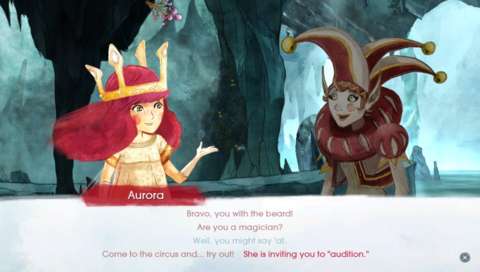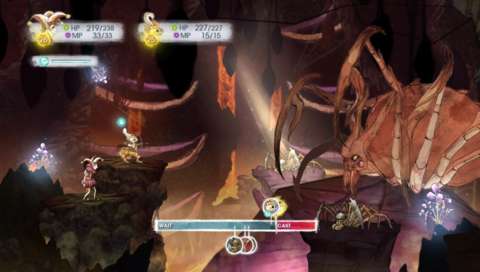Fairy tales may be works of escapism, but no fairy tale worth its salt is purely a work of frivolous fantasy. No, the best fairy tales simultaneously let children escape from the frightening realities of life, while also helping them confront those realities, teaching them that even though life is difficult and scary sometimes, they are capable of overcoming adversity and coping with loss. Child of Light is a fine fairy tale in this tradition, a fantasy that deals with the reality of what it means to grow up. It's also a gorgeous game with an engaging turn-based battle system and wondrous realms that are a joy to discover and explore. After coming to consoles and PC earlier this year, the game has made its way to the Vita, and it's as excellent as ever.
Child of Light tells the story of Aurora, daughter of an Austrian duke in the late 1800s who finds herself transported to the land of Lemuria. Here, she learns that it is her destiny to recover the sun, moon, and stars from the evil queen who has stolen the light from the land. At first, she is understandably reluctant and even petulant about having this responsibility thrust upon her shoulders when all she wants to do is wake up back in Austria and hurry to her heartsick father's side. It's the way that she grows over the course of the game that makes her journey meaningful. She befriends a diverse group of characters who all have struggles of their own and who find their strength in each other, and her journey is empowering, but not altogether joyous. Child of Light is a richer game for the ways in which it acknowledges the hard decisions and the inevitable sadness that are part and parcel of leaving childhood behind.

Unfortunately, the game's writing sometimes distracts from the emotion of its story. Characters speak in rhyme, and at times, the words they use are clumsy and forced, chosen to fit into the rhyming structure rather than to effectively communicate what the characters are thinking or feeling. At least the game has some fun with its own convention via the character of Rubella, an aspiring circus jester who goofs up every exchange, using a word that doesn't rhyme with what came before ("vocalist") when a perfectly common and obvious word ("singer") would have worked just fine.
But if the writing sometimes keeps you at arms length, the visuals pull you in completely. The distinctive realms of Lemuria are more reminiscent of the off-kilter fantasy lands of films like The Neverending Story and The Dark Crystal than of the Tolkienesque high fantasy that informs so many games. Your quest takes you high and low, to platforms held in the sky by massive balloons and into crystal caverns under the surface of the land. and everywhere you go, their melancholy beauty makes them a pleasure to behold, and their imaginative design creates the feeling that you don't know what other strange wonders Lemuria might have for you to discover.

You travel through Lemuria from a two-dimensional side-view perspective, and though you're bound to the ground like an ordinary girl when the game begins, early on you gain the power of flight. There are plenty of treasure chests for you to discover and optional side quests to complete, giving you an incentive to venture off the beaten path, soar up into the skies and explore every nook and cranny of these lands. Many areas also have environmental hazards and traps for you to avoid, and though these never pose too much of a challenge, they make navigating the world a bit trickier and more involving than it would be if it didn't have any dangers.
The real danger of Lemuria is in its monsters. You can see them in the environment which typically makes avoiding them easy, but more often than not, you'll want to fly into them, both because Child of Light's combat is enjoyable and because you'll want to level up your characters to prepare them for the challenges ahead. Battles are built on a foundation of traditional turn-based role-playing game combat, but there are enough wrinkles here to give you plenty to think about. You can rarely just spam standard attacks endlessly on your way to victory.
You can only have two characters in combat at any one time, but you can swap out one character for another instantly when his or her turn comes along, and switching between characters with the offensive muscle you want and those with the healing abilities you need to stay alive is one concern. And you can use the glow of Aurora's firefly friend Igniculus to slow down enemies' progress along the timeline. Your goal with this is typically to have your attacks strike enemies just before they would have attack you, which interrupts their attacks and knocks them backwards on the timeline, effectively denying them a chance to act. It's particularly satisfying to get into a rhythm where you keep knocking enemies back, using Igniculus to slow them down just enough so that they're right where you want them and then using your characters' own attacks to interrupt them again and again.

Battles are also rewarding because of the steady clip at which your characters level up. After almost every battle, at least one of your characters advances, getting boosts to stats as well as earning skill points that you can use to unlock additional stat boosts or more powerful skills. Of course, it's fun to see your characters become stronger over the course of the game, but what makes Child of Light meaningful is the way that Aurora grows emotionally stronger. Eventually we have to leave the realms of fairy tales behind and face the challenges of reality once more, but Lemuria is the kind of fantasy realm that stays with you as long as you remain a child somewhere in your heart.